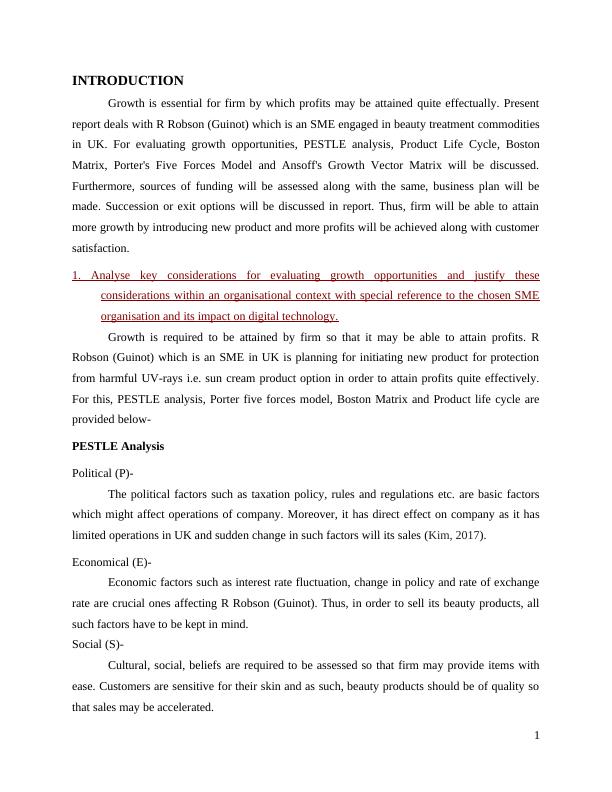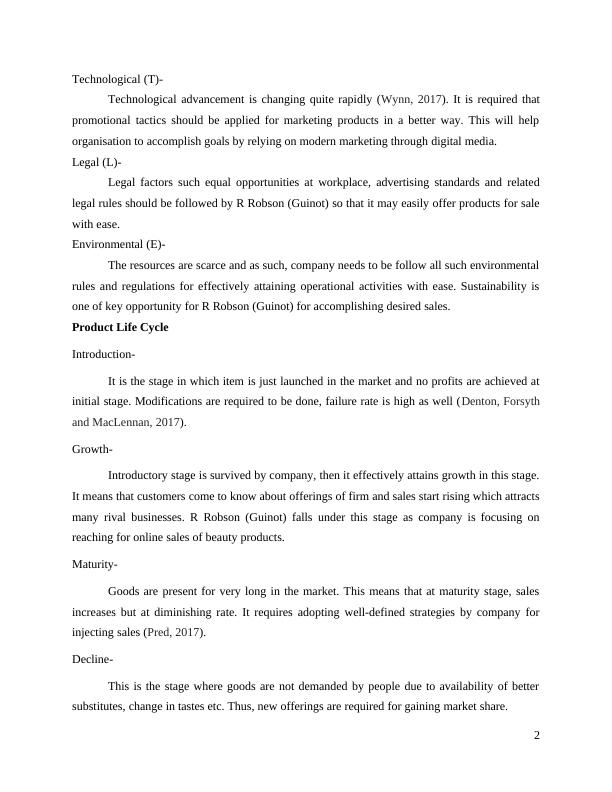Unit 42 Planning for Growth - Doc
15 Pages3690 Words368 Views
Added on 2020-10-05
Unit 42 Planning for Growth - Doc
Added on 2020-10-05
ShareRelated Documents
UNIT 42 PLANNING FORGROWTH

Table of ContentsINTRODUCTION...........................................................................................................................11. Analyse key considerations for evaluating growth opportunities and justify theseconsiderations within an organisational context with special reference to the chosen SMEorganisation and its impact on digital technology.......................................................................12. Evaluate the opportunities for growth applying Ansoff’s growth vector matrix for thechosen SME organisation............................................................................................................43. Assess the potential sources of funding available to businesses and discuss benefits anddrawbacks of each source............................................................................................................54. Design a business plan for growth that includes financial information and strategicobjectives for scaling up your chosen business...........................................................................75. Assess exit or succession options for the small business chosen for the purpose, explainingthe benefits and drawbacks of each option...............................................................................10CONCLUSION..............................................................................................................................11REFERENCES..............................................................................................................................13

INTRODUCTIONGrowth is essential for firm by which profits may be attained quite effectually. Presentreport deals with R Robson (Guinot) which is an SME engaged in beauty treatment commoditiesin UK. For evaluating growth opportunities, PESTLE analysis, Product Life Cycle, BostonMatrix, Porter's Five Forces Model and Ansoff's Growth Vector Matrix will be discussed.Furthermore, sources of funding will be assessed along with the same, business plan will bemade. Succession or exit options will be discussed in report. Thus, firm will be able to attainmore growth by introducing new product and more profits will be achieved along with customersatisfaction.1. Analyse key considerations for evaluating growth opportunities and justify theseconsiderations within an organisational context with special reference to the chosen SMEorganisation and its impact on digital technology.Growth is required to be attained by firm so that it may be able to attain profits. RRobson (Guinot) which is an SME in UK is planning for initiating new product for protectionfrom harmful UV-rays i.e. sun cream product option in order to attain profits quite effectively.For this, PESTLE analysis, Porter five forces model, Boston Matrix and Product life cycle areprovided below-PESTLE AnalysisPolitical (P)-The political factors such as taxation policy, rules and regulations etc. are basic factorswhich might affect operations of company. Moreover, it has direct effect on company as it haslimited operations in UK and sudden change in such factors will its sales (Kim, 2017). Economical (E)-Economic factors such as interest rate fluctuation, change in policy and rate of exchangerate are crucial ones affecting R Robson (Guinot). Thus, in order to sell its beauty products, allsuch factors have to be kept in mind.Social (S)-Cultural, social, beliefs are required to be assessed so that firm may provide items withease. Customers are sensitive for their skin and as such, beauty products should be of quality sothat sales may be accelerated.1

Technological (T)-Technological advancement is changing quite rapidly (Wynn, 2017). It is required thatpromotional tactics should be applied for marketing products in a better way. This will helporganisation to accomplish goals by relying on modern marketing through digital media.Legal (L)-Legal factors such equal opportunities at workplace, advertising standards and relatedlegal rules should be followed by R Robson (Guinot) so that it may easily offer products for salewith ease.Environmental (E)-The resources are scarce and as such, company needs to be follow all such environmentalrules and regulations for effectively attaining operational activities with ease. Sustainability isone of key opportunity for R Robson (Guinot) for accomplishing desired sales.Product Life CycleIntroduction- It is the stage in which item is just launched in the market and no profits are achieved atinitial stage. Modifications are required to be done, failure rate is high as well (Denton, Forsythand MacLennan, 2017).Growth-Introductory stage is survived by company, then it effectively attains growth in this stage.It means that customers come to know about offerings of firm and sales start rising which attractsmany rival businesses. R Robson (Guinot) falls under this stage as company is focusing onreaching for online sales of beauty products. Maturity-Goods are present for very long in the market. This means that at maturity stage, salesincreases but at diminishing rate. It requires adopting well-defined strategies by company forinjecting sales (Pred, 2017).Decline-This is the stage where goods are not demanded by people due to availability of bettersubstitutes, change in tastes etc. Thus, new offerings are required for gaining market share.2

End of preview
Want to access all the pages? Upload your documents or become a member.
Related Documents
P1. Analysing key considerations for evaluating growth opportunitieslg...
|16
|4819
|412
Planning For Growth And Opportunities (pdf)lg...
|14
|3664
|18
Growth Opportunities for R Robson (Guinot): An Analysislg...
|16
|4463
|75
Planning for growth in R Robson 10lg...
|21
|5460
|283
Evaluation of growth pathways and growth pathwayslg...
|19
|4397
|495
Planning for Growthlg...
|16
|4824
|80
